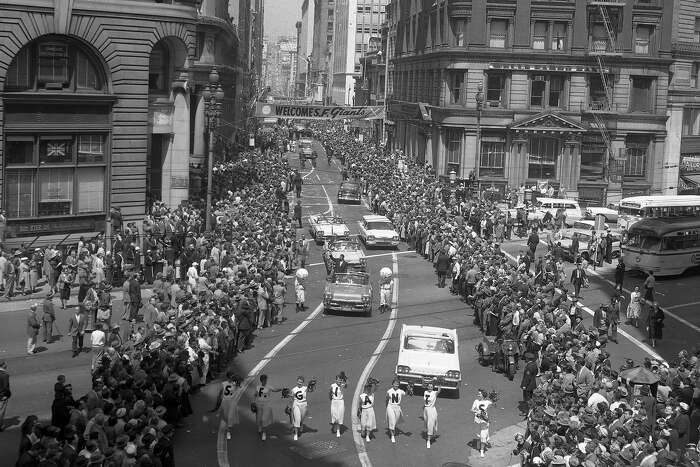This is a carousel. Use Next and Previous buttons to navigate
The plans look like something downloaded from “Mad Men” protagonist Don Draper’s brain.
In 1965, when Bay Area Rapid Transit was still more than seven years away from transporting passengers, the agency gave customers the most detailed look yet at their transit future. It was, to say the least, optimistic. Seatback maps! A classy analog next-train countdown clock near the turnstiles! A Geary Street line!
BART dropped a handful of prototype cars — sort of like model homes — into urban centers. They also released multiple drawings of stations and platforms.
“BART’s Dream Car: The Luxury Route for Commuters,” the April 22, 1965, Chronicle story was headlined, the day after both debuted.
“We’ve got to compete with the luxury of today’s autos,” General Manager B.R. Stokes was quoted as saying. “And I think we’ve got something that only, possibly, a jetliner can compare with.”
Like the temporary BART logo, which was thinner and loopier than the final version, everything was a little bit off from the eventual reality. “Serene futurism” is the description Chronicle architecture critic John King offered when showed the BART drawings. That sounds about perfect.

As the transit system approaches its 44th anniversary next month, it’s easy to forget how excruciating the wait was for a San Francisco subway, and the impact the drawings and model cars must have made.
The words “Bay Area Rapid Transit” first appeared in The Chronicle in the 1940s. Plans for an underground or above-ground train network went back much further. The Chronicle ran a front-page editorial demanding a subway in 1900.
Throughout the 1950s and early ’60s, BART supporters released the usual pie-in-the-sky drawings, maps and architectural plans, most of them clearly a wish list to drum up voter support. But the 1965 drawings made more than vague promises, and future commuters could walk inside the cars. For the first time, it felt real.

“啧啧,观众是音响,所以是几sour gripes — at yesterday’s unveiling ceremonies of the Bay Area Rapid Transit District’s new passenger car,” Chronicle reporter Michael Grieg’s story began.
When The Chronicle pointed out that there were no straps or bars for standing passengers to steady themselves, BART President Adrien J. Falk responded with optimism.
“The reason there are no straps to hang from is because we expect to seat everybody,” Falk said. “The schedule will be staggered so there’ll be a new train along every 90 seconds.”
一段喜剧从同一篇文章,responding to concerns about vandalism: “We tried to make the car so attractive it will discourage malice of this sort,” Falk added. “Anyway, the cars will be equipped with a radio system so passengers can notify headquarters or the station ahead when vandalism occurs.”
The architectural drawings supported his vision, showing a future with no crowds, no advertisements, and everyone seemingly dressed for a fantastic cocktail party. There’s a video camera on the ceiling in one of the 1965 photos, presumably operational. In one of the renderings, a woman walks toward her station with her wallet wide open, taking out money or a ticket — pretty much the worst idea at a BART station in 2016.
But look with a less jaded attitude and there are even more key promises that were kept. The final design was indeed Space Age enough for none other than George Lucas to use as a backdrop for his attempt at feature film science fiction, “THX-1138.”
The turnstiles in the drawings were actually bulkier and less streamlined than the finished product. The artist’s rendition of an Oakland elevated platform looks remarkably like the real thing in 2016. And the pre-Manhattanization San Francisco skyline in the background is a reminder that the system for decades managed to grow with the region.
There’s something to be said for a system that has lasted 45 years, using basically the same design and much of the same technology. The sour gripes continue, and the floors are a little less shiny. But BART soldiers on.
Peter Hartlaub is The San Francisco Chronicle’s pop culture critic. Email:phartlaub@sfchronicle.comTwitter:@PeterHartlaub.


























